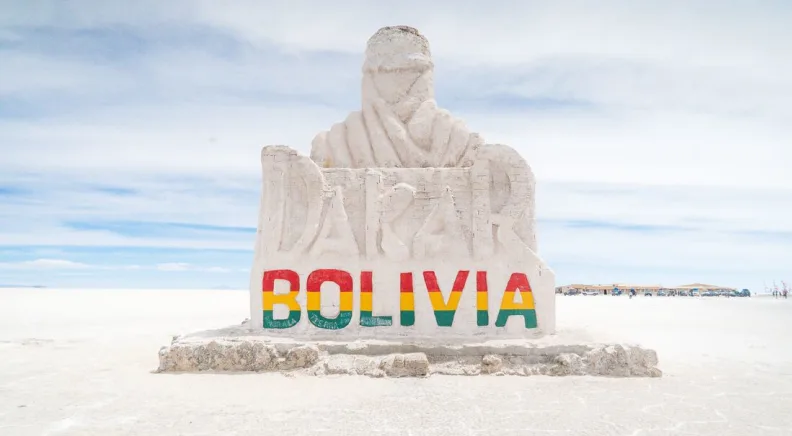Explore the best of Bolivia on this 11-day adventure through dramatic cities, remote Andean villages and lunar-like deserts. Find yourself wandering the Witches Market in La Paz, exploring the surreal salt flats of Salar de Uyuni and strolling past grand mansions in Sucre. You’ll hit the hotspots of this fascinating part of South America while getting to know the rich culture and spirit of its people.


Bolivia Highlights
Deal number: 2197413
Intrepid
This deal expires 21 Dec 2025
From 25/12/2025 to 02/01/2028
Bolivia
11-day tour
Price from
$2,224*
per person
Deal number: 2197413
Explore one of the world’s highest cities, La Paz! Take an urban cable car for epic valley views, shop for potions in the Witches Market or hunt for the best choripan (Bolivian hot dog).
Buckle up for a 4WD adventure through the Andean Desert. Barren, haunting and spectacular, the laws of earthly physics seem to bend on the surreal Salar de Uyuni salt flats.
Choose to visit the otherworldly landscape of Valle de la Luna – a maze of canyons and colossal clay spires that makes you feel you’re walking on the moon.
Get close to 68-million-year-old dinosaur footprints and visit grand mansions in the historic capital of Sucre.
Learn about Bolivia’s past as you explore the narrow streets and Spanish architecture of Potosi, which was once one of the wealthiest cities in the world.
Breakfasts Included: 10
Lunches Included: 3
Dinners Included: 2
Dormitory (1 night), Hotel (8 nights), Basic Hotel (1 night)
Plane, 4X4, Local bus, Private Vehicle
Age: min 15
Group Size: 1 - 12
La Paz - Orientation Walk
Salt flats - Visit to 'Fish Island/Inca Wasi'
Eduardo Avaroa National Reserve - Altiplano tour including Laguna Colorada
Sucre - Dinosaur Footprints
Sucre - Orientation Walk
Sucre - Chataquila Pre-Inca trek
Buckle up for a 4WD adventure through the Andean Desert. Barren, haunting and spectacular, the laws of earthly physics seem to bend on the surreal Salar de Uyuni salt flats.
Choose to visit the otherworldly landscape of Valle de la Luna – a maze of canyons and colossal clay spires that makes you feel you’re walking on the moon.
Get close to 68-million-year-old dinosaur footprints and visit grand mansions in the historic capital of Sucre.
Learn about Bolivia’s past as you explore the narrow streets and Spanish architecture of Potosi, which was once one of the wealthiest cities in the world.
Breakfasts Included: 10
Lunches Included: 3
Dinners Included: 2
Dormitory (1 night), Hotel (8 nights), Basic Hotel (1 night)
Plane, 4X4, Local bus, Private Vehicle
Age: min 15
Group Size: 1 - 12
La Paz - Orientation Walk
Salt flats - Visit to 'Fish Island/Inca Wasi'
Eduardo Avaroa National Reserve - Altiplano tour including Laguna Colorada
Sucre - Dinosaur Footprints
Sucre - Orientation Walk
Sucre - Chataquila Pre-Inca trek
1 La Paz
Hola! Welcome to Bolivia. Sitting in a deep canyon 3600 m above sea level, you’ll feel on top of the world in La Paz. Your trip begins with a welcome meeting at 6 pm. After, maybe head out for a walk with your local leader and group. While Sucre is the official capital, La Paz is bigger and has a lot happening! Perhaps visit the weird and wacky Witches Market, grab a drink in the bohemian streets of Calle Jaen or take to the sky in an urban cable car – make sure your camera is charged because the views of the surrounding peaks are pretty special.
2 La Paz – Uyuni
Leave La Paz this morning and travel by private vehicle to Uyuni – the gateway to Bolivia’s acclaimed salt flats. You’ll arrive in the late afternoon, so be sure to have a podcast and snacks ready. Uyuni feels a bit like you've reached the end of the road, which is true in a way. This remote town sits on the edge of the high altiplano – a wilderness extending hundreds of kilometres towards the border with Argentina and Chile. After checking into your hotel, the evening is yours to relax. Although basic, the rooms are clean and comfortable – and it may be the last time you’ll have a hot shower for a few days!
3 Salar de Uyuni
Uyuni is the starting point of your 4WD adventure to Salar de Uyuni in the Andean Desert. This morning, you’ll stop by the eerie Train Cemetery where abandoned locomotives rust in the sun. Continue to Colchani – a town that produces salt the old-fashioned way, before heading into the salt flats. With endless skies that meet endless white plains, it's a hypnotic sight! Then, pop into an intriguing salt hotel and drive to an island of cacti that rises like a jagged reef in the desert. Known as Isla Inca Wasi, or Fish Island, this fossil-strewn outcrop was once the top of an ancient volcano – you’ll have the chance to go on an optional hike here. Continue south to your homestay-style accommodation in a small village and refuel with an included dinner.
4 Desierto Siloli – Laguna Colorada
After breakfast, hit the road through the incredible wilderness of the Andean Desert. Pass by Chiguana Salt Lake, the active Ollague Volcano and other small lakes of various colours – perhaps with a streak of pink if flamingos are nearby! Continue to the Siloli Desert – known for its seven-coloured mountain and Arbol de Piedra (Stone Tree) rock formation. You’ll also visit an Andean wildlife reserve (Reserva de Eduardo Avaroa) and hike around the Laguna Colorada (Red Lake) – keep an eye out for llamas, vicunas and foxes along the way. After a big day, head to your accommodation in a local community (either Huayllajara or Polques) for a well-earned rest and an included dinner.
5 Salar de Uyuni – Uyuni
Rise early to try to catch the sunrise over the surrounding geysers. These bubbling fumaroles are especially active in the morning thanks to the cold air. There may also be an opportunity to visit a hot spring for an optional morning dip. After, drive through more barren landscapes – some of which are frequently compared to Salvador Dali’s paintings – to the strikingly green Laguna Verde, Valle de Rocas (Rock Valley) and the San Cristobal mining town. You’ll return to Uyuni around 5 pm to spend the night at your leisure. After a few days in the desert, you may want to check out a local restaurant with your group for an optional dinner and drinks.
6 Potosi
This morning, say goodbye to Uyuni and board a local bus for a scenic ride to the city of Potosi in Bolivia's southern highlands. Potosi has a turbulent past, centred mostly around its mining successes and failures. Once the leading supplier of silver to colonial-era Spain, it briefly claimed to be one of the wealthiest cities in the world. Explore the architectural remnants of this period on an orientation walk with your leader, followed by free time for the rest of the day. Perhaps visit the National Mint Museum or the Santa Teresa Convent Museum to see the art and treasures within the convent’s original walls.
7 Sucre
After a free morning in Potosi, take a local bus to the temperate valley city of Sucre, Bolivia's official capital. Sucre was declared a UNESCO World Heritage site in 1991 and has retained much of its colonial heritage in its churches, museums and mansions. Most of the colonial buildings have been whitewashed, hence the city's nickname, the 'White City'. When you arrive, the rest of the afternoon is yours to relax or find your bearings. Tonight, maybe see if your group wants to grab dinner – Sucre is known for mondongo (pork ribs) and saltenas (Bolivian empanadas).
8 Sucre
Spend the day exploring Bolivia’s capital. After an orientation walk with your leader, compare shoe sizes with a dinosaur at Cal Orcko – home to 68-million-year-old footprints and the world’s largest collection (over 12,000!) of dinosaur footprints. Then, you might like to visit the Museo de la Recoleta – a 400-year-old convent with a fascinating collection of sculptures and paintings and great city views. Or maybe head to the Plaza 25 de Mayo to mingle with Sucre's affluent residents and wander the ornate interior of the Senora de la Merced.
9 Sucre
Today, set off for a hike along the ancient Pre-Incan path known as the Chataquila trek. This (mostly downhill) trek is relatively easy and offers stunning views of the Andes. You have free time for the rest of the afternoon. There are plenty of optional activities in and around town, so what you get up to is up to you! Bolivian dance show or textile museum, anyone?
10 Sucre - La Paz
Depending on flight time and availability, you’ll fly back to La Paz in the morning or afternoon. When you arrive, maybe visit the Coca Museum to learn about the history and significance of the coca plant in South American cultures – or just kick back at your hotel.
11 La Paz
Your Bolivian adventure comes to an end after breakfast. With no activities planned, you’re free to leave anytime. With so much to see and do, you might want to spend an extra day or two in the city – just get in touch with your booking agent ahead of time.
Hola! Welcome to Bolivia. Sitting in a deep canyon 3600 m above sea level, you’ll feel on top of the world in La Paz. Your trip begins with a welcome meeting at 6 pm. After, maybe head out for a walk with your local leader and group. While Sucre is the official capital, La Paz is bigger and has a lot happening! Perhaps visit the weird and wacky Witches Market, grab a drink in the bohemian streets of Calle Jaen or take to the sky in an urban cable car – make sure your camera is charged because the views of the surrounding peaks are pretty special.
2 La Paz – Uyuni
Leave La Paz this morning and travel by private vehicle to Uyuni – the gateway to Bolivia’s acclaimed salt flats. You’ll arrive in the late afternoon, so be sure to have a podcast and snacks ready. Uyuni feels a bit like you've reached the end of the road, which is true in a way. This remote town sits on the edge of the high altiplano – a wilderness extending hundreds of kilometres towards the border with Argentina and Chile. After checking into your hotel, the evening is yours to relax. Although basic, the rooms are clean and comfortable – and it may be the last time you’ll have a hot shower for a few days!
3 Salar de Uyuni
Uyuni is the starting point of your 4WD adventure to Salar de Uyuni in the Andean Desert. This morning, you’ll stop by the eerie Train Cemetery where abandoned locomotives rust in the sun. Continue to Colchani – a town that produces salt the old-fashioned way, before heading into the salt flats. With endless skies that meet endless white plains, it's a hypnotic sight! Then, pop into an intriguing salt hotel and drive to an island of cacti that rises like a jagged reef in the desert. Known as Isla Inca Wasi, or Fish Island, this fossil-strewn outcrop was once the top of an ancient volcano – you’ll have the chance to go on an optional hike here. Continue south to your homestay-style accommodation in a small village and refuel with an included dinner.
4 Desierto Siloli – Laguna Colorada
After breakfast, hit the road through the incredible wilderness of the Andean Desert. Pass by Chiguana Salt Lake, the active Ollague Volcano and other small lakes of various colours – perhaps with a streak of pink if flamingos are nearby! Continue to the Siloli Desert – known for its seven-coloured mountain and Arbol de Piedra (Stone Tree) rock formation. You’ll also visit an Andean wildlife reserve (Reserva de Eduardo Avaroa) and hike around the Laguna Colorada (Red Lake) – keep an eye out for llamas, vicunas and foxes along the way. After a big day, head to your accommodation in a local community (either Huayllajara or Polques) for a well-earned rest and an included dinner.
5 Salar de Uyuni – Uyuni
Rise early to try to catch the sunrise over the surrounding geysers. These bubbling fumaroles are especially active in the morning thanks to the cold air. There may also be an opportunity to visit a hot spring for an optional morning dip. After, drive through more barren landscapes – some of which are frequently compared to Salvador Dali’s paintings – to the strikingly green Laguna Verde, Valle de Rocas (Rock Valley) and the San Cristobal mining town. You’ll return to Uyuni around 5 pm to spend the night at your leisure. After a few days in the desert, you may want to check out a local restaurant with your group for an optional dinner and drinks.
6 Potosi
This morning, say goodbye to Uyuni and board a local bus for a scenic ride to the city of Potosi in Bolivia's southern highlands. Potosi has a turbulent past, centred mostly around its mining successes and failures. Once the leading supplier of silver to colonial-era Spain, it briefly claimed to be one of the wealthiest cities in the world. Explore the architectural remnants of this period on an orientation walk with your leader, followed by free time for the rest of the day. Perhaps visit the National Mint Museum or the Santa Teresa Convent Museum to see the art and treasures within the convent’s original walls.
7 Sucre
After a free morning in Potosi, take a local bus to the temperate valley city of Sucre, Bolivia's official capital. Sucre was declared a UNESCO World Heritage site in 1991 and has retained much of its colonial heritage in its churches, museums and mansions. Most of the colonial buildings have been whitewashed, hence the city's nickname, the 'White City'. When you arrive, the rest of the afternoon is yours to relax or find your bearings. Tonight, maybe see if your group wants to grab dinner – Sucre is known for mondongo (pork ribs) and saltenas (Bolivian empanadas).
8 Sucre
Spend the day exploring Bolivia’s capital. After an orientation walk with your leader, compare shoe sizes with a dinosaur at Cal Orcko – home to 68-million-year-old footprints and the world’s largest collection (over 12,000!) of dinosaur footprints. Then, you might like to visit the Museo de la Recoleta – a 400-year-old convent with a fascinating collection of sculptures and paintings and great city views. Or maybe head to the Plaza 25 de Mayo to mingle with Sucre's affluent residents and wander the ornate interior of the Senora de la Merced.
9 Sucre
Today, set off for a hike along the ancient Pre-Incan path known as the Chataquila trek. This (mostly downhill) trek is relatively easy and offers stunning views of the Andes. You have free time for the rest of the afternoon. There are plenty of optional activities in and around town, so what you get up to is up to you! Bolivian dance show or textile museum, anyone?
10 Sucre - La Paz
Depending on flight time and availability, you’ll fly back to La Paz in the morning or afternoon. When you arrive, maybe visit the Coca Museum to learn about the history and significance of the coca plant in South American cultures – or just kick back at your hotel.
11 La Paz
Your Bolivian adventure comes to an end after breakfast. With no activities planned, you’re free to leave anytime. With so much to see and do, you might want to spend an extra day or two in the city – just get in touch with your booking agent ahead of time.
Enquire to book this trip
Deal number: 2197413
Bolivia Highlights
Intrepid

From 25/12/2025 to 02/01/2028
Bolivia
11-day tour




